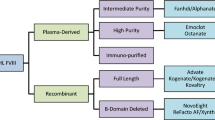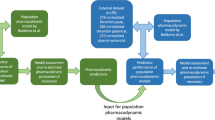Abstract
Purpose
Dosing of enoxaparin, like other anticoagulants, may result in bleeding following excessive doses and clot formation if the dose is too low. We recently showed that a factor Xa based clotting time test could potentially assess the effect of enoxaparin on the clotting system. However, the test did not perform well in subsequent individuals and effectiveness of an exogenous phospholipid, Actin FS, in reducing the variability in the clotting time was assessed. The aim of this work was to conduct an adaptive pilot study to determine the range of concentrations of Xa and Actin FS to take forward into a proof-of-concept study.
Methods
A nonlinear parametric function was developed to describe the response surface over the factors of interest. An adaptive method was used to estimate the parameters using a D-optimal design criterion. In order to provide a reasonable probability of observing a success of the clotting time test, a P-optimal design criterion was incorporated using a loss function to describe the hybrid DP-optimality.
Results
The use of adaptive DP-optimality method resulted in an efficient estimation of model parameters using data from only 6 healthy volunteers. The use of response surface modelling identified a range of sets of Xa and Actin FS concentrations, any of which could be used for the proof-of-concept study.
Conclusions
This study shows that parsimonious adaptive DP-optimal designs may provide both precise parameter estimates for response surface modelling as well as clinical confidence in the potential benefits of the study.





Similar content being viewed by others
Abbreviations
- ACS:
-
Acute coronary syndrome
- aPTT:
-
Activated partial thromboplastin time
- AT:
-
Antithrombin
- BSV:
-
Between subject variability
- CT:
-
Clotting time
- DVT:
-
Deep vein thrombosis
- LMWH:
-
Low molecular weight heparin
- PE:
-
Pulmonary embolism
- PT:
-
Prothrombin time
- RE:
-
Relative error
- TenaCT:
-
Ten-a clotting time
- TT:
-
Thrombin time
- UFH:
-
Unfractionated heparin
- VTE:
-
Venous thromboembolism
- g :
-
Unit of acceleration
- j :
-
Index for a parameter
- J :
-
Jacobian matrix
- k :
-
Index for iteration
- K D :
-
Affinity constant
- M F :
-
Fisher information matrix
- |M F (⋅)|:
-
Determinant of the Fisher information matrix
- p :
-
Total number of parameters
- T:
-
Transpose
- U :
-
Utility function
- ξ 0 :
-
Initial design
- ξ * D :
-
D-optimal design
- ξ * DP :
-
DP-optimal design
- β :
-
Any parameter in a model
- \( \widehat{\beta} \) :
-
Estimate of any parameter in a model
- \( \overline{\beta} \) :
-
Mean of any parameter in a model
- β :
-
Vector of parameters in the model
- \( \widehat{\boldsymbol{\upbeta}} \) :
-
Vector of the estimated parameters
- Σ :
-
Covariance of the residual error
References
Gulati A, Faed JM, Isbister GK, Duffull SB. Development and evaluation of a prototype of a novel clotting time test to monitor enoxaparin. Pharm Res. 2012;29(1):225–35.
Bauer P, Rohmel J. An adaptive method for establishing a dose–response relationship. Stat Med. 1995;14(14):1595–607.
Whitehead J. Bayesian decision procedures with application to dose-finding studies. Int J Pharm Med. 1997;11:201–8.
Zhang W, Sargent DJ, Mandrekar S. An adaptive dose-finding design incorporating both toxicity and efficacy. Stat Med. 2006;25(14):2365–83.
Foo LK, Duffull S. Adaptive optimal design for bridging studies with an application to population pharmacokinetic studies. Pharm Res. 2012;29(6):1530–43.
Gulati A, Isbister GK, Duffull SB. Effect of Australian elapid venoms on blood coagulation: Australian Snakebite Project (ASP-17). Toxicon. 2013;61:94–104.
Marciniak E. Factor-Xa inactivation by antithrombin. 3. Evidence for biological stabilization of factor Xa by factor V-phospholipid complex. Br J Haematol. 1973;24(3):391–400.
Bjornsson TD, Wolfram KM. Intersubject variability in the anticoagulant response to heparin in vitro. Eur J Clin Pharmacol. 1982;21(6):491–7.
ACKNOWLEDGMENTS AND DISCLOSURES
The authors acknowledge the support of University of Otago Postgraduate Scholarship and the University of Otago Research Grant 2011.
Author information
Authors and Affiliations
Corresponding author
Rights and permissions
About this article
Cite this article
Gulati, A., Faed, J.M., Isbister, G.K. et al. Application of Adaptive DP-optimality to Design a Pilot Study for a Clotting Time Test for Enoxaparin. Pharm Res 32, 3391–3402 (2015). https://doi.org/10.1007/s11095-015-1715-1
Received:
Accepted:
Published:
Issue Date:
DOI: https://doi.org/10.1007/s11095-015-1715-1




